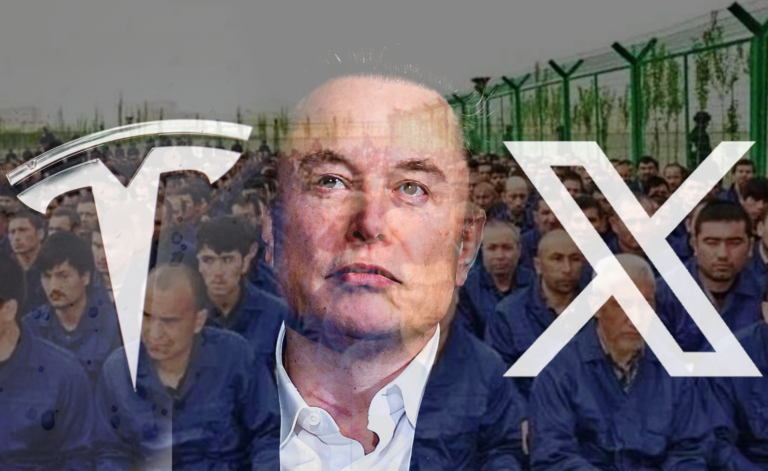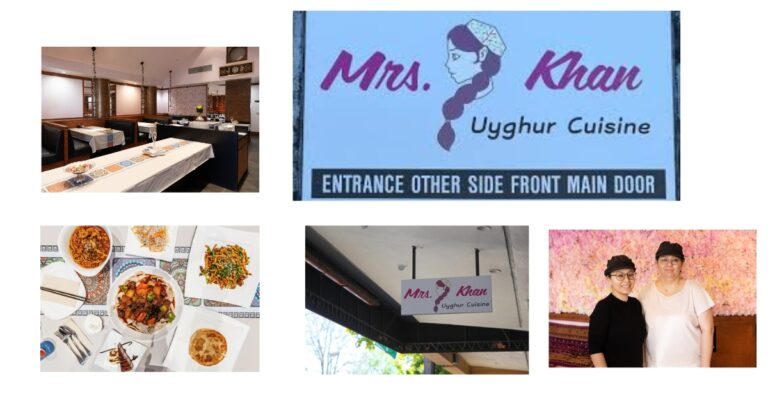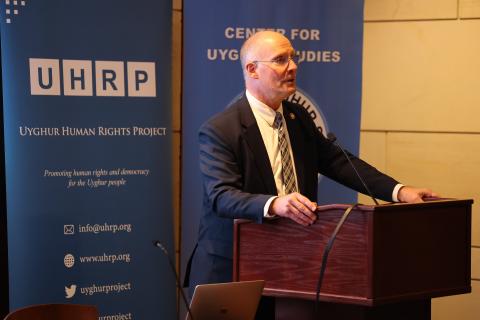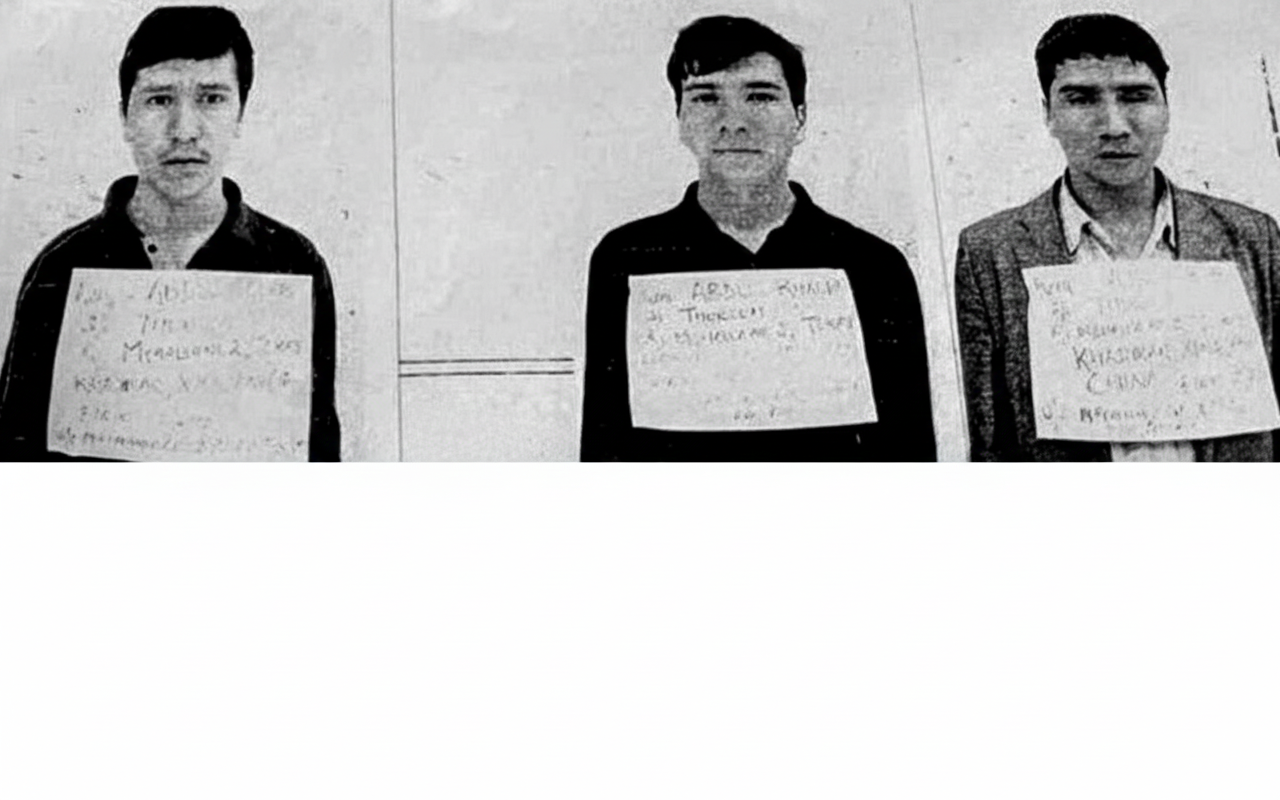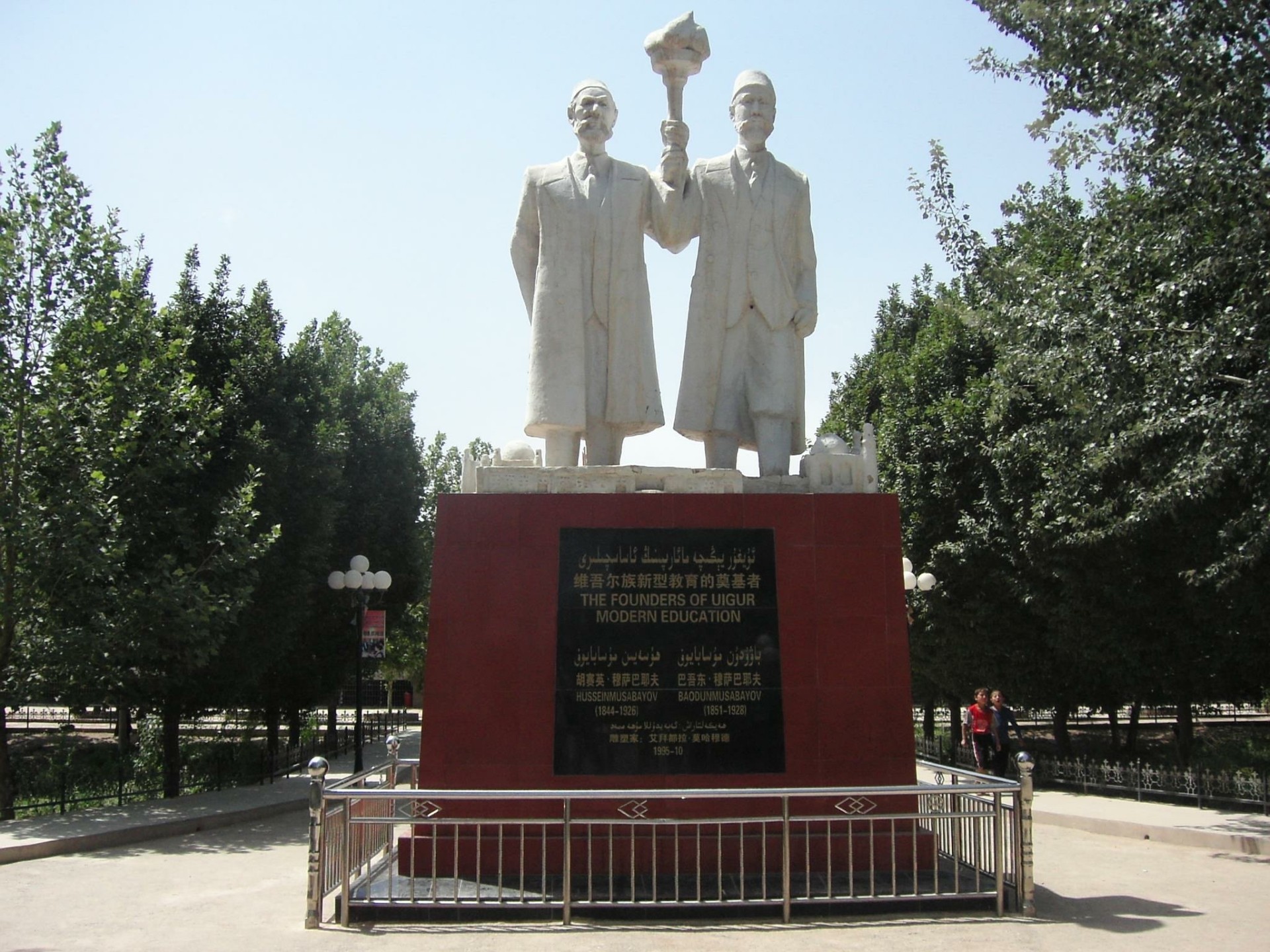
The Musabay Family مۇسابايلار ئائىلىسى
Disclaimer: The original article was written by Uyghur author Yalqun Ruzi and published in his book The Secret of the Mud Castle. It was prepared by Nuri Musabay ( Nurmemet Musabay) a member of the Musabay family and a Uyghur activist residing in Virginia, USA.
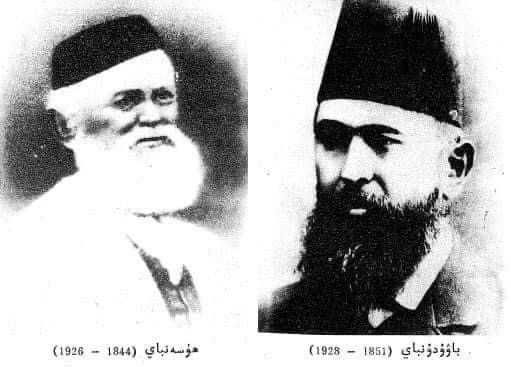
The Musabay family is one of the most renowned families in the Uyghur region. Their ancestral homeland is the village of Iksaq in Upper Artush (Ustun Artush), located 27.26 kilometers northwest of Kashgar in the southern region of Uyghur homeland, which is currently under Chinese occupation.
The Musabay family has played a crucial role in Uyghur history and is recognized as one of the wealthiest and most influential Uyghur families. They led the innovation movement in the Uyghur homeland, East Turkestan (جەددىچىلىك ھەركىتى، يېڭىلىققا كۆچۈش ھەركىتى).
What makes the Musabay family unique is that they championed both modern education and national industry while upholding the cause of Uyghur freedom and pride. Their efforts were dedicated to the independence of the Uyghur people.
Nine Major Contributions of the Musabay Family
Memorial Statue
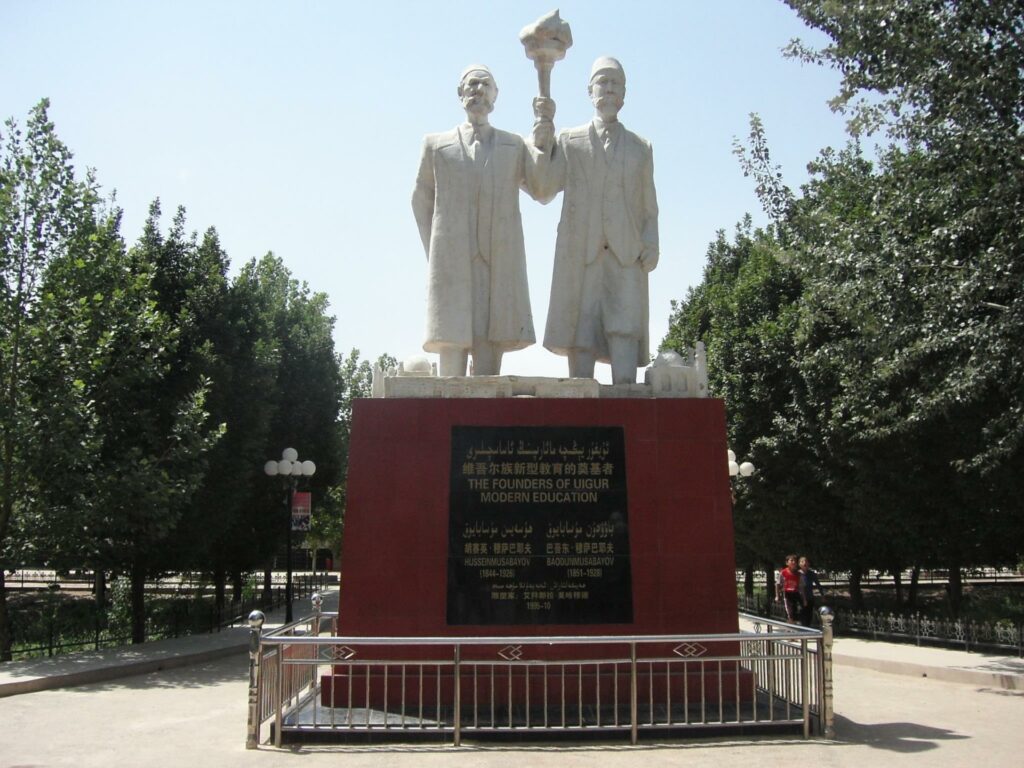
(According to Radio Free Asia, the statue was destroyed by the Chinse government in 2018)
Contribution 1: Establishment of the Musabay Leather Factory
With the founding of the Musabay Leather Factory, the Musabay family led Uyghurs into industrialization. They introduced bourgeois and capitalist ideas to their homeland, becoming the first Uyghur capitalists.
The Musabay Leather Factory was established in 1909 in Ghulja (Ili, 伊宁市). The factory’s equipment, machinery, and techniques were imported from Germany, and German technicians were contracted to train Uyghur specialists. Bahawudun I Musabay negotiated with the Russian Empire to transport the factory’s equipment through Russian territory within 90 days. The equipment was moved using trains, boats, sledges, and horse-/cow-drawn carts, with new roads and bridges built along the way. The journey was successfully completed within the stipulated time, and the factory construction was finalized in 1909.
The Musabay Leather Factory was established just three years after the Jiangnan Leather Factory, which was founded in Shanghai in 1906 as a joint venture between the Japanese and the Qing Dynasty.
(See Sherip Hushtar’s book and Yalkun Rose’s book “The Secret of the Mud Castle,” page 82.)
When China invaded East Turkestan in 1949, some members of the Musabay family fled abroad. Those who could not escape were imprisoned, and the Chinese government confiscated all of the Musabay family’s wealth and property, including the leather factory.
Since the 2000s, the factory’s equipment and workshops have been sold to Chinese migrants. Eventually, the entire factory complex was demolished and replaced with residential buildings for Chinese settlers. The factory’s iconic tall chimney, a historical symbol of Uyghur industrialization, was demolished in early 2004, erasing one of the last physical remnants of Uyghur industry.
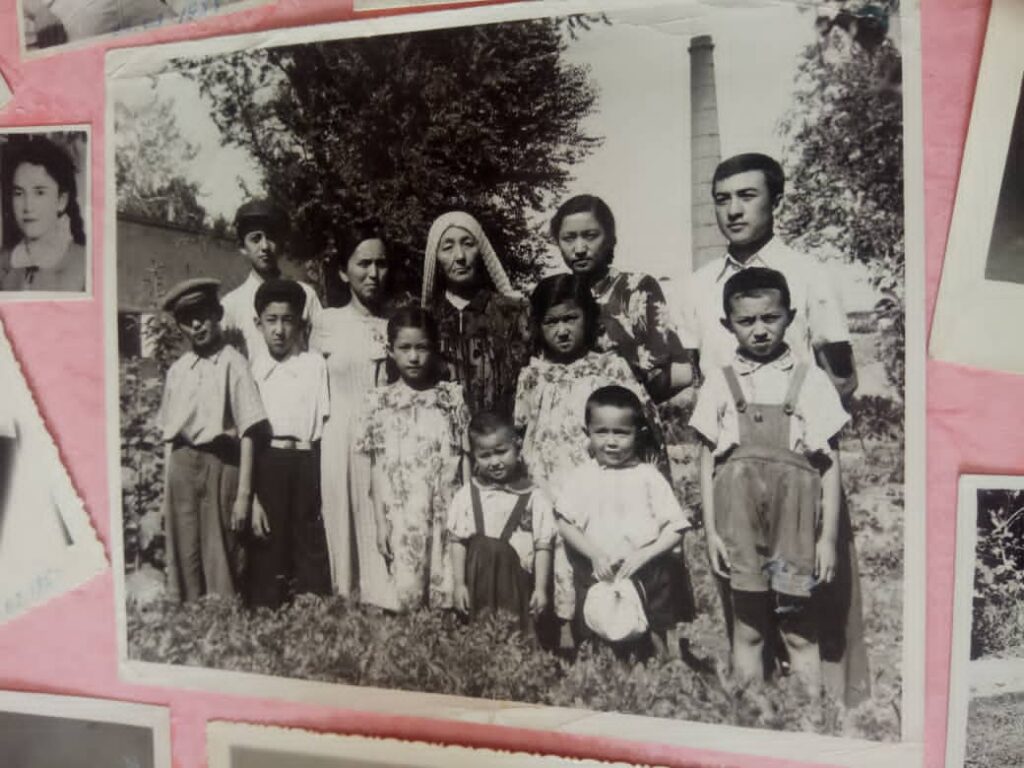
Photo: The Musabay Family in the Early 1950s, Ghulja City
This photo was taken at the Musabay Leather Factory compound.Back row, left to right:
Feridon, the second son of Abliz Musabay
Mrs. Rukiyagul, daughter of Bahawudun Musabay, wife of Abliz Musabay
Mrs. Rabegul, wife of Bahawudun Musabay, mother of Mrs. Rukiyagul
Mrs. Maghpura, granddaughter of Bahadunbay (Lady Maryam’s daughter). Maghpura’s husband, Ghani, was Ahmetjan Qasim’s bodyguard and was killed alongside him in a plane crash.
Nijat, son of Ghani’s sister
Front row, left to right:
Front row from left to right:
.Abdursul, the 5th son of Abliz Musabay. 2. Adiham, the son of Mrs. Magpura (in Tashkent).
3. Dilnavaz, Maghpura’s daughter (Tashkent). 4. Identity unknown. 5. Nilufer, daughter of Magpura. 6. Ilshat, the younger son of Abliz Musabay. 7. Identity unknown
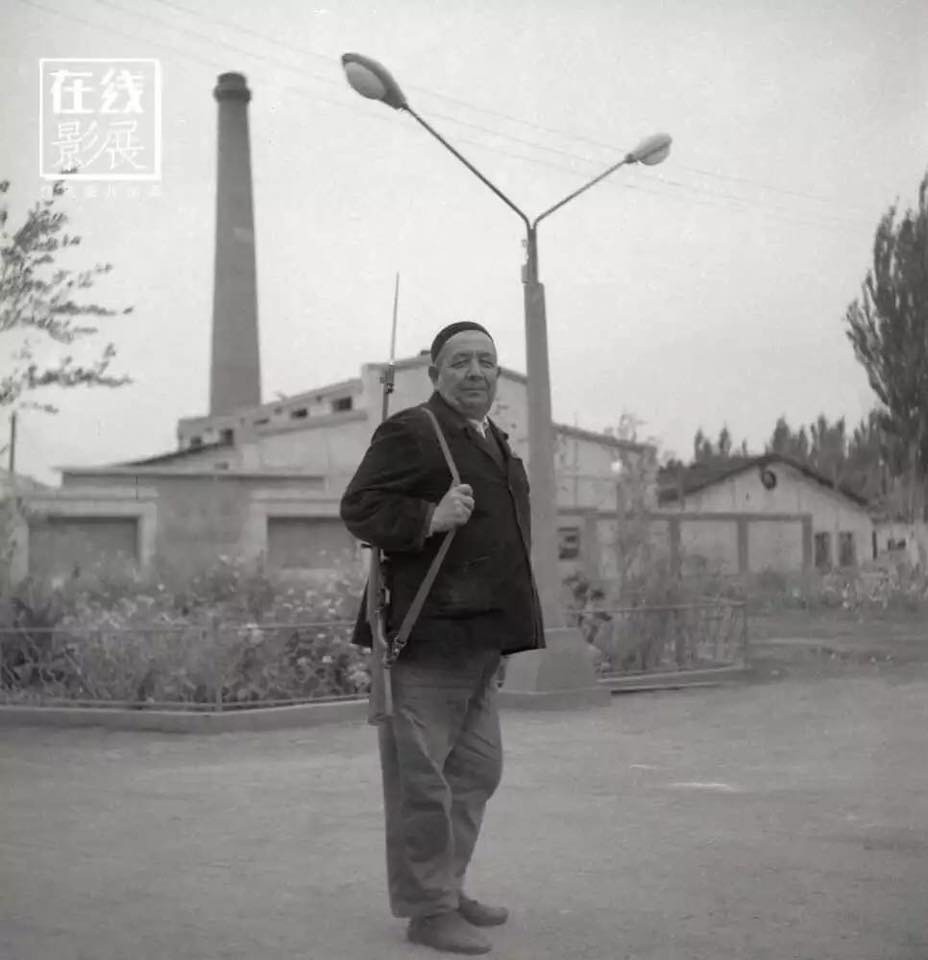
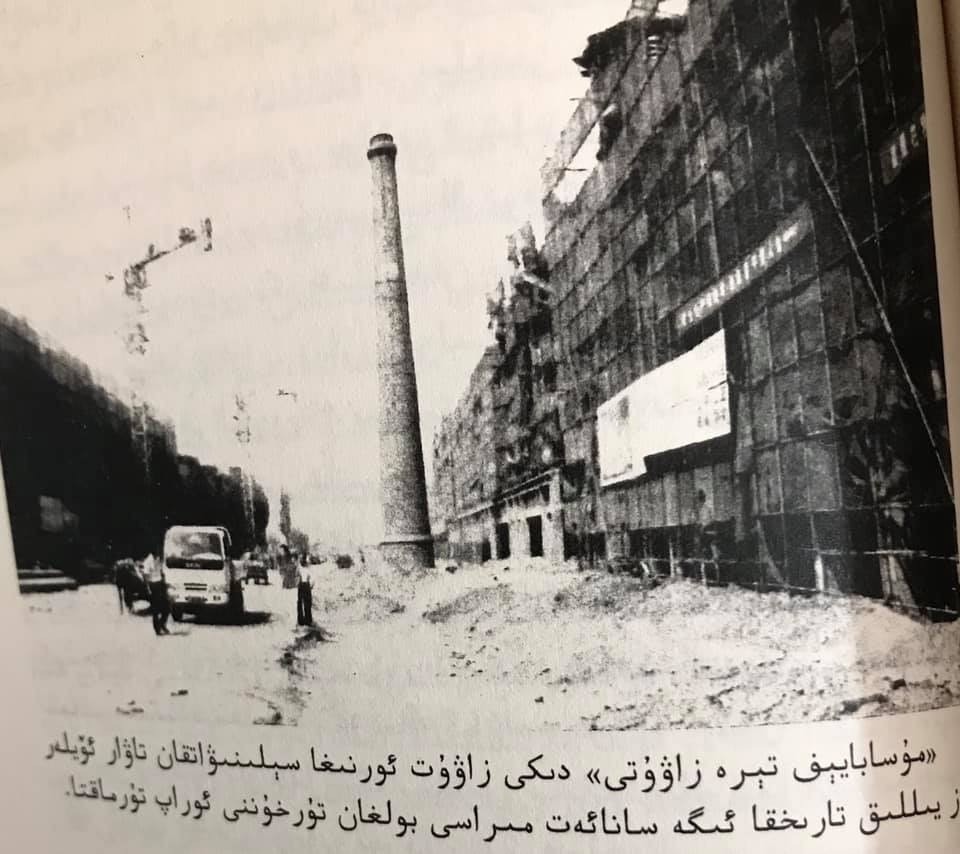
New commercial buildings are being built to replace the Musabay leather factory complex, surrounding the factory building, a 100-year-old industrial heritage of the tall chimney of factory, in years 2000s.
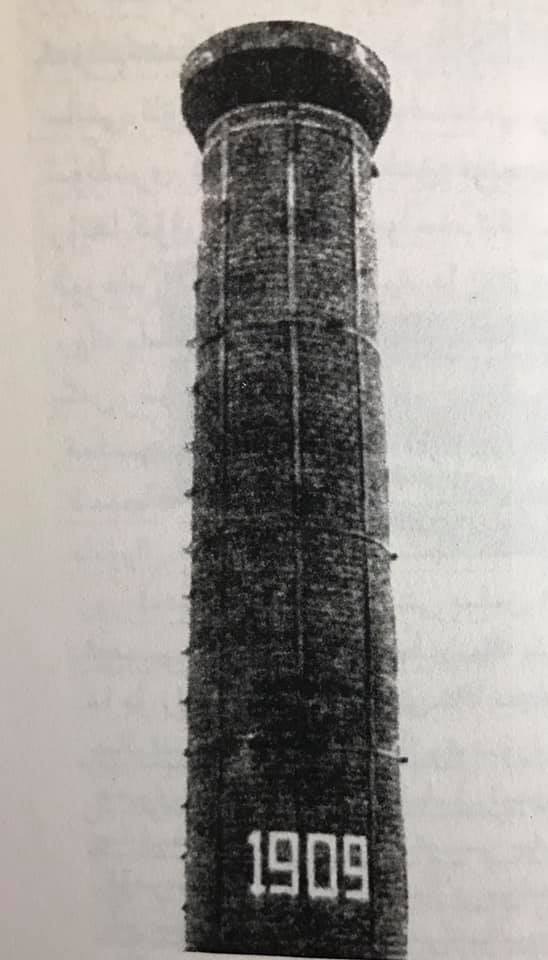
Contribution 2: The New Education Movement and the First Modern Uyghur School
The Musabay family pioneered the modern Uyghur education movement, implementing national education reforms and building the first Western-style Uyghur school, which provided free education for Uyghur children.
According to Chinese government publications, the Musabay brothers founded the first Western-style Uyghur school in 1885 in Iksaq village, Upper Artush (ئىكساق، ئۇستۇن ئارتۇش). However, testimonies from elderly Uyghurs and former students, as published in the Mash’al Magazine (1983), state that the school was originally founded in Kashgar in 1872 during Yaqub Beg’s rule. Following the Chinese/Manchu occupation of East Turkestan in 1885, the school was forced to relocate to Iksaq.
A brief note in the book Famous People in the Recent History of Xinjiang (page 377) acknowledges the Musabay brothers’ role in modern Uyghur education. The school, named “Huseyniya,” opened with 105 students, including 25 female students, and employed 20 teachers and staff members. Male teachers were referred to as “Sir,” while female teachers were called “Ma’am.”
Contribution 3: Sending Uyghur Students Abroad
In 1872, the Qing Dynasty began sending Chinese students abroad for education. Inspired by this, the Musabay family initiated the same practice for Uyghurs.
In 1898, they sent Kerim Ahun, the first Uyghur student, to study in Orenburg, Russia. Following this, around 30 Uyghur students were funded by the Musabay family to study in major cities such as Moscow, Cairo, Istanbul, Berlin, Paris, Tashkent, Orenburg, and Kazan.
The Musabay family was the only Uyghur family to launch an innovation movement comparable to Japan’s Meiji Restoration.
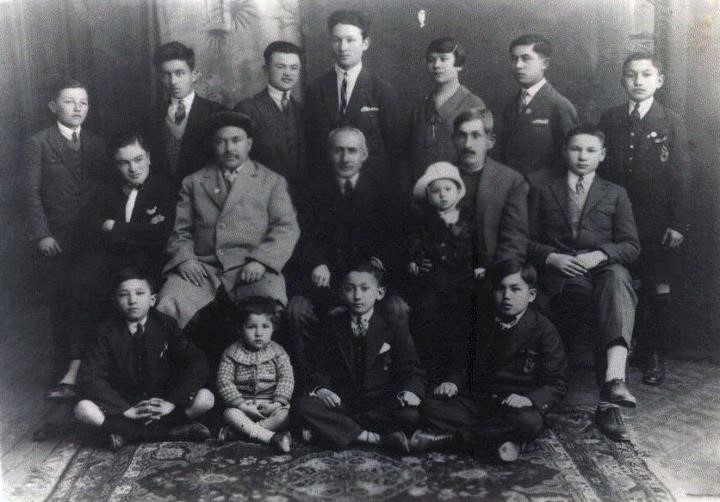
Front row from left: 1st person: Rashithaji. (Husenbay’s & Bahawudunbay’s sister’s, lady Omara’s grandson. 3rd: Abdul Qayyum Musabay (Qayyum Musabay, son of Bahawudun Musabay). The 4th person is Anwar Musabay (son of Ablahaji, brother of Husenbay and Bahaudunbay).
2nd row, 1st from the left is Abdulhay (known as Ilham Musabay in Turkey, Husen Musabay’s son). The 2nd person is Abdurrahman Haji, the brother of Rashithaji’s father Hebibullah Hajim. The 3rd person is Mr. Abdurrahman (Shadi). 4th. the Boy Fuat Musabay (son of Bahawudun Musabay) in the arms of an unknown person. 5th person Mahmut Abzi (Tatar).
3rd row from the left, 1st person is Masud Aldigarup (Tatar), 2nd person is Ismail Musabay (son of Bahawudun Musabay). 3rd person is Mijit Musabay (son of Husen Musabay). The 4th person is Malik Bektemir (Tatar). The 5th person is Mrs.
Mehrusa (Tatar). The 6th person is Abliz Musabay (son of Husen Musabay). 7th Abdulhaq (Ablah) (son of Hussenbay and Bahawudunbay’s brother Hesamuddin).
Contribution 4: Implementation of vocational education.
After the equipment of the Musabay Leather factory arrived in Ghulja city, the Musabay brothers opened a regular technical school to train technicians and workers in the middle of 1908 near the factory, at the location of today’s Ili Pedagogical University. Later, for the training of women and girls, set up appropriate class for women, such as needlework (embroidery) and sewing (machining).
Two famous Uyghur generals, Zunun Teyip and Mamatiminop were educated in this Musabay family opened vocational school in Ghulja city.
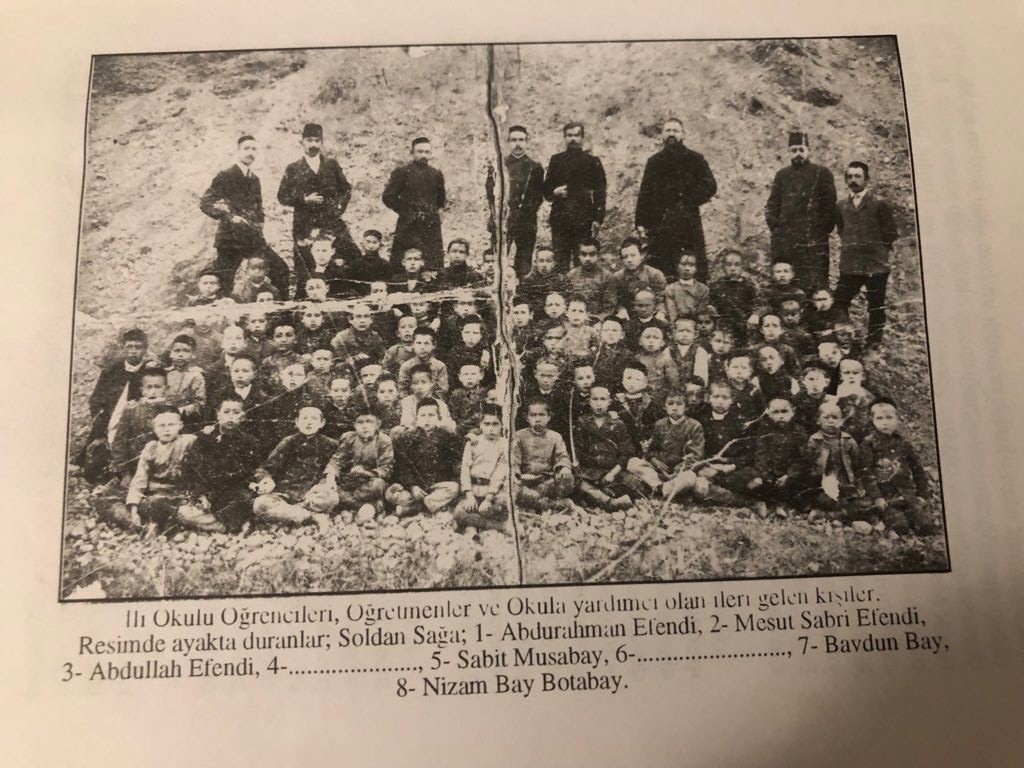
The Photo Taken from a book about Masut Sabiri, published by Masut Sabri’s daughter.
Standing in the back row from left: 2nd Masut Sabri, 5th Sabit (Sawut) Musabay (nephew of Bahawudun I Musabay). The 7th person is Bahawudun I Musabay.
Contribution 5: Establishing Pedagogical Schools ( دارىلمۇئالىمىن) Darilmu’alimin)..
After building the first modern Uyghur school in Iksaq, Artush in 1885, Bahawudun I Musabay talked with the Ottoman Empire, and in 1914, he invited Mr. Ahmet Kamal and founded Artush Iksaq Pedagogical Schools. (Darilmu’alimin) ( دارىلمۇئالىمىن). Also, Mr. Ababekri, Mr. Abdurrahman, and Mr. Mukerram Qari were invited from Turkey and raised the educational platform of Darilmu’allimin.
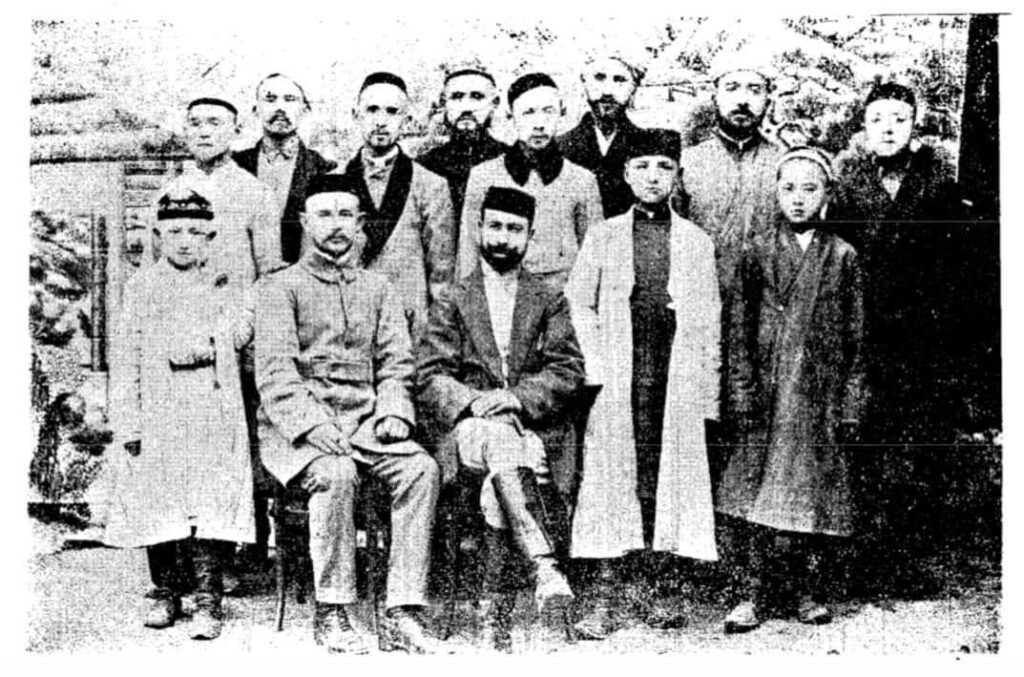
(On the right of Ahmet Kamal, the man in the white coat, Obulhasen I Musabay, a younger brother of Husenbay and Bahawudunbay Musabay)
6. Contribution: the introduction of electricity, telephone, automobile and move film
Bahawudun I Musabay paid special attention to the developments in Europe when he traveled around Europe with his business. the Uyghurs regretted that they were far behind these developments. He made many efforts so that the Uyghurs could benefit from these developments and that the Uyghurs would also face new developments. and made the aforementioned contributions.
When Bahawudun I Musabay brought the factory equipment from Germany, he also brought the necessary electricity for the factory (electric generator), as well as telephones, movies, and cars.
At that time, there was no film screening or viewing in the Uyghur homeland. The Musabay family brought the first cinematographs and films from Germany.
At that time, only Zhangjun/General of Ili/Ghulja Military District had a telephone in his home and office.
Musabay family established a telephone line between “Factory facilities/yard” “ “زاۋۇد قورۇ of Musabay, the location was today’s Ili Leather Factory; ” School yard” “مەكتەپ قورۇ” location was today’s Ili Pedagogical University; “Kontor (Control) koro”, “كونتور قورۇ” the head office of Musabay, located was in today’s the People’s Square of ili/Ghulja City; “Moyka koro مويكا قورو” “، washing wool facilities”, Bagh koro “باغ قورۇ” residential and offices yard “,
these two yards are connected to each other, and location was today’s the offices of Chinese communist part Ili oblast branch. The Musabay family connected these five places with telephone line
Bahawudun I Musabay brought a Mercedes car from Germany and went to his home to those five facilities. At that time, there was only a government-supplied Mitsubishi car of Zhangjun/General, the Ili/Ghulja Military garrison in Ghulja.
Contribution 7: Import football and start football activities.
The Musabay brothers sent to Turkey for study in 1905. Mr. Tursun, and Mr. Abdurrahman (Shadi) finished their studies. When they returned to the motherland in 1915, they taught the teachers in Iksak teachers how to play football.
In 1920, when Mr. Abdul Rahman (shadi) was the headmaster of a junior high school in Ghulja, he organized a football tournament in Ghulja.
Mr. Tursun founded the “Huseyniye” school football team in Iksak and expanded football activities to Kashgar district.
The Iksak Huseyniye school football team played against the British, Swedish, and Soviet consular teams at that time and beat them.
The Musabay family is the founder and media of the modern Uyghur sports movement.
Contribution 8: Update livestock breeds.
The Ili /Ghulja region is a pastoral area with endless grasslands. Farming was an important part and foundation of the Musabay brothers’ business. The Musabay family had pastures/ meadows/land all over the Ili/Ghulja region. They had many Horses, cattle, sheep in these pastures/ meadows/land.
For example, Kolilengsu, yalghuz terek/ Sol Poplark, Nilqa, Suptay, Kunes, Tikes, and Bayimbulak had pastures/ meadows/land. they had thousands of large and small livestock in these pastures/ meadows/land. The Musabay brothers raised the cattle and Horse platform and imported new breeds of cattle and Horse from abroad.
Imported woolly white sheep) (ئاق مېتىسقوي wool weaving. Wool was washed in Moyka and exported. Dairy cattle that give a lot of milk White and black cattle (ئالا كالا) were also brought from abroad, and sheep and cattle breeds were bred.
Bahawudun I Musabay also brought dozens of stallions from Ukraine and Kazakhstan to Gulja, and updated the varieties of horses. The varieties of these imported horses were named Anglo-Arabian, English European, and Badakhshan European
Contribution 9: Creating a spirit of Musabay’s.
With the expansion of Musabay Brothers’ operations abroad, they have operated in European countries and Turkey.
They were inspired by the development of education in foreign countries, the development of new teaching and learning, industrial developments, European freedoms, revolutions, and democratic movements. In order to change the fate of the Uyghur people, they brought the advanced techniques, styles, and ideas to the Uyghur people and their homeland.
The Musabay brothers felt that the Uyghurs were far behind in the development of the world and felt sad. They also realized that the Uyghurs have the right to live independently, just like other peoples.
However, the cultural level of the Uyghur people at that time was very low, the Uyghur people were far from advanced technologies and world development, there were few advanced people, and there was simply no political consciousness. First, they intended to raise the cultural level of the people, create conditions for the increase of educated and knowledgeable people, improve the economic conditions of the people, and awaken the people.
And after they are making the above-mentioned contributions, the Uyghur economy improved, cultural level, political education, nationalism and patriotism were carried out.
The Musabay family provided a lot of material and spiritual support, economic support and directly participated in the post-awakening revolutions in Uyghur Land-East Turkistan.
They played an important role in the establishment of the first and second republics. Supported materially, economically and spiritually. served as ministers in both republics.
Obulhasen I Musabay was the minister of trade and industry in the first republic. (he is younger brother of Husenbay & Bahawudunbay Musabay), He was assassinated by Xingxisai in 1934). Talat Musabay (Hussenbay’s son) also worked as a secretary in first republic.
In the Second Republic, Anwar Musabay (son of Ablahajim, younger brother of the Musabay brothers). He was the Minister of the finance minister.
Ismail Musabay (Bahawudunbay’s eldest son) was the central bank governor and the director of the arms procurement department.
The Second Republic Army’s boots, winter boots, winter coats, and horse gear were provided by Musabay leather Factory.
In the last 100 years of Uyghur history, there are two famous families who have worked for the Uyghur people in politics, economics, and education. They are the Musabay family and the Muhidi family.
